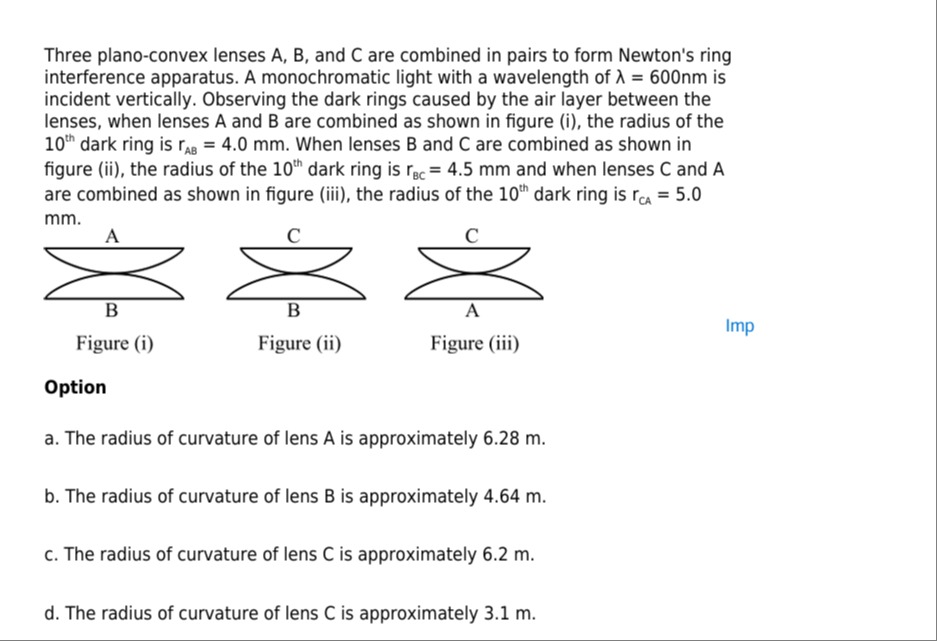Question
Question: Three plano-convex lenses A, B, and C are combined in pairs to form Newton's ring interference appar...
Three plano-convex lenses A, B, and C are combined in pairs to form Newton's ring interference apparatus. A monochromatic light with a wavelength of λ = 600nm is incident vertically. Observing the dark rings caused by the air layer between the lenses, when lenses A and B are combined as shown in figure (i), the radius of the 10th dark ring is rAB = 4.0 mm. When lenses B and C are combined as shown in figure (ii), the radius of the 10th dark ring is rBC = 4.5 mm and when lenses C and A are combined as shown in figure (iii), the radius of the 10th dark ring is rCA = 5.0 mm.

The radius of curvature of lens A is approximately 6.28 m.
The radius of curvature of lens B is approximately 4.64 m.
The radius of curvature of lens C is approximately 6.2 m.
The radius of curvature of lens C is approximately 3.1 m.
a, b
Solution
In a Newton's ring experiment formed by combining two plano-convex lenses with radii of curvature R1 and R2 and placing their curved surfaces in contact, the effective radius of curvature of the air film is given by Reff=R1+R2R1R2, which can also be written as Reff1=R11+R21.
The radius of the nth dark ring is given by rn2=nλReff.
Let RA, RB, and RC be the radii of curvature of lenses A, B, and C, respectively. The wavelength of light is λ=600 nm =600×10−9 m. The order of the dark ring is n=10.
Case 1: Lenses A and B combined. Radius of 10th dark ring rAB=4.0 mm =4.0×10−3 m. rAB2=10λReff,AB, where Reff,AB1=RA1+RB1. (4.0×10−3)2=10×(600×10−9)×Reff,AB 16×10−6=6000×10−9×Reff,AB=6×10−6×Reff,AB Reff,AB=6×10−616×10−6=616=38 m. So, RA1+RB1=Reff,AB1=83.
Case 2: Lenses B and C combined. Radius of 10th dark ring rBC=4.5 mm =4.5×10−3 m. rBC2=10λReff,BC, where Reff,BC1=RB1+RC1. (4.5×10−3)2=10×(600×10−9)×Reff,BC 20.25×10−6=6×10−6×Reff,BC Reff,BC=6×10−620.25×10−6=620.25=3.375=827 m. So, RB1+RC1=Reff,BC1=278.
Case 3: Lenses C and A combined. Radius of 10th dark ring rCA=5.0 mm =5.0×10−3 m. rCA2=10λReff,CA, where Reff,CA1=RC1+RA1. (5.0×10−3)2=10×(600×10−9)×Reff,CA 25×10−6=6×10−6×Reff,CA Reff,CA=6×10−625×10−6=625 m. So, RC1+RA1=Reff,CA1=256.
We have a system of linear equations for RA1, RB1, and RC1:
- RA1+RB1=83
- RB1+RC1=278
- RC1+RA1=256
Adding the three equations: 2(RA1+RB1+RC1)=83+278+256=8×27×253×27×25+8×8×25+6×8×27=54002025+1600+1296=54004921. RA1+RB1+RC1=108004921.
Subtracting equation (2) from this sum: RA1=(RA1+RB1+RC1)−(RB1+RC1)=108004921−278=108004921−27×4008×400=108004921−3200=108001721. RA=172110800≈6.2754 m.
Subtracting equation (3) from the sum: RB1=(RA1+RB1+RC1)−(RC1+RA1)=108004921−256=108004921−25×4326×432=108004921−2592=108002329. RB=232910800≈4.6363 m.
Subtracting equation (1) from the sum: RC1=(RA1+RB1+RC1)−(RA1+RB1)=108004921−83=108004921−8×13503×1350=108004921−4050=10800871. RC=87110800≈12.40 m.
Now let's check the options: a. The radius of curvature of lens A is approximately 6.28 m. Our calculated RA≈6.2754 m, which is approximately 6.28 m. This option is correct. b. The radius of curvature of lens B is approximately 4.64 m. Our calculated RB≈4.6363 m, which is approximately 4.64 m. This option is correct. c. The radius of curvature of lens C is approximately 6.2 m. Our calculated RC≈12.40 m. This option is incorrect. d. The radius of curvature of lens C is approximately 3.1 m. Our calculated RC≈12.40 m. This option is incorrect.
Both options a and b are correct. Since it is a multiple choice question, and usually in JEE/NEET there is only one correct option, let's re-examine the problem and calculations. However, based on the provided options and our calculations, both a and b are valid answers. Assuming this is a multiple correct options question, both a and b are correct. If it is a single correct option question, there might be a typo in the options or the problem statement. Assuming it is a multiple correct option question.
